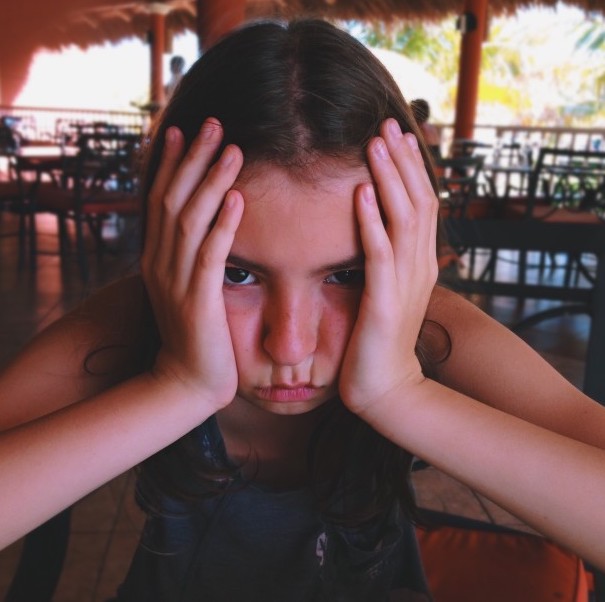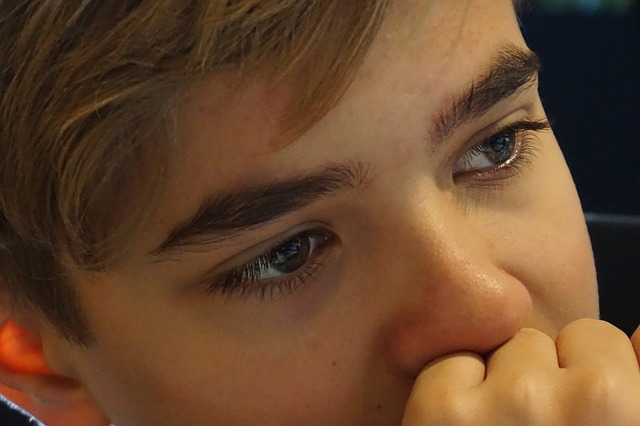 Educator, author, and public speaker, and parent Julie Lythcott-Haims shares her perspective drawn from her own experience about how to re-pattern a family dynamic to reduce kids’ anxiety.
Educator, author, and public speaker, and parent Julie Lythcott-Haims shares her perspective drawn from her own experience about how to re-pattern a family dynamic to reduce kids’ anxiety.
It’s late Spring of 2006. My son Sawyer is about to turn seven. My daughter Avery is about to turn five. The parents of Sawyer’s friend Zach G invite the four of us over to their place for dinner. As the evening nears, Zach G’s dad emails me to say that they’ll be barbecuing a variety of sausages for dinner, and he wants to know if there are any kinds of sausage that we don’t particularly like? My insides lurch. While Avery eats everything, Dan will cope with whatever, and I love pretty much anything that comes off a barbecue including sausages of all varieties, I know that my dear Sawyer is not likely to eat a single sausage no matter what variety it is.
At home we have a rule that you have to try three bites of the main meal and then you can have something else. But how will this work on the road? Will Sawyer just go hungry? Or will Dan and I hunt among the dishes Zach G’s family has prepared in the hope that we will find something Sawyer might like, then push him to try it? And what will that do to the mood of the evening? Should I tell Zach G’s dad that it’s likely that Sawyer won’t eat any sausages? I mean he asked, me, right? But I’m pretty sure that when I was a kid people just ate what was offered, and that there’s etiquette around that. I worry for days.
Then I come up with a plan. A few hours before the dinner, I make some penne pasta with butter and parmesan cheese. I put it in a Tupperware and pop it in my bag. We get to Zach G’s. The grownups catch up in the kitchen and around the grill while the kids play. We all sit down at the picnic table in the lovely backyard. The sausage is proffered. Sawyer looks up at me with his beautiful brown eyes. I tell him to try some. I also point at my bag and nod reassuringly. Nobody makes a big deal or anything. We are fine.
But, were we?
It would be fourteen long years before The Atlantic would publish a groundbreaking piece on childhood anxiety that describes how well-intended “accommodating” behaviors on the part of us parents are linked to the development of anxiety in our kids. Yet back in 2006 as I held a pot of buttered pasta in my left hand and shook the green can of fake cheese with my right, I’ll admit I’d already started asking myself What’s your long-term plan, here, lady? Still, the long term wasn’t on my mind as I prepared for the barbecue that night. My boy being satisfied at dinner was what mattered. That, and harmony.
In the Atlantic article (“What Happened to American Childhood,” May 2020), journalist Kate Julian explains that, “Far too often, we insulate our children from distress and discomfort entirely. And children who don’t learn to cope with distress face a rough path to adulthood.” She continues, “The everyday efforts we make to prevent kids’ distress—minimizing things that worry them or scare them, assisting with difficult tasks rather than letting them struggle—may not help them manage it in the long term.” This is putting it quite mildly, as I would understand by the end of the article.
Julian’s article centers on the work of Yale professor Eli Lebowitz who studies the everyday things parents do to prevent their kid’s distress yet which are correlated with the development of anxiety in children. She cites about a dozen examples of such parenting behavior from Lebowitz’ lab, including these three:
1) If your kid is afraid of the dark and you go to all lengths to ensure that your kid is never in the dark;
2) If your kid is afraid of being alone and you go to all lengths to ensure that your kid is never alone; and
3) If your kid prefers certain foods and you go to all lengths to ensure that your kid is never without them.
Whelp. I sit transfixed at my kitchen counter. I feel a tad paranoid. I am, after all, the author of a book that explains that kids who have over-involved parents are more likely to have anxiety and depression, and lack skills and executive function. Yet I am oh-so-clearly the prototypical parent from scenario three, who once made pasta with butter and parm not just for the barbecue at Zach G’s house, but, to be honest, for Christmas and Thanksgiving and almost every dinner, really. (I assure you I was just doing what I thought was right, y’all!) And my kid these many years later does have a considerable amount of anxiety. I want to look the other way. Avoid the possible correlation. But I can’t.
I tell myself, At least I’m not the lady who peed in a bucket. (This fate befell a parent whose young son was afraid of being alone. She was with him in the basement playroom and when she felt the urge to go, instead of tromping upstairs to use the bathroom she found a bucket, and well….) I also reassure myself that I was never as bad as the parents of “Owen,” a child who only ate turkey meatloaf for lunch and dinner, and by the time he was six-years-old his parents figured they’d served it to him over 3,000 times. Still, I see enough of myself in this article to go Well, how about that. I had cut Sawyer’s meat until he was ten, I remind myself.
Julian takes care to understand why we parents may feel the need to accommodate to the nth degree. We’re obviously not trying to undermine our kids, nor would we ever willingly do anything to foment anxiety in them. So, what gives? She quotes best-selling author Ned Johnson (The Self-Driven Child; What Do You Say?) who explains, “When we shelter kids from difficulty or challenge… we are not merely shielding them from distress; we are warding off the distress that their distress causes us.” This was a punch in the gut. Was my concern over making things easier for Sawyer really about making things easier for ME?
Another reason we accommodate, Julian says, is that life is just so damn busy. We parents swoop in and take care of business (as I had that night at dinner when I cut ten-year-old Sawyer’s meat) because it makes dinner, and therefore evening, and therefore bedtime, and therefore life, go more smoothly. She quotes Lebowitz as saying that a big driver for all of the accommodating is simply that we just need to get out the door in the morning to get our kids to school and ourselves to work. It doesn’t sound quite so awful when you look at it that way, does it?
Julian’s piece then pierces the heart of the matter. “If modern parents are so unrelentingly on top of things, why have we not corrected course? Could it be that we are not at all on top of things? Might our children’s faltering mental health be related less to our hard-driving style than to our exhaustion and guilt and failure to put our foot down? We complain about kids being thin-skinned and susceptible to peer pressure, but maybe we’re the ones who are hypersensitive, to the judgment of our peers and, especially, of our children. And the harder we try to do the right thing—the more we nurture them, the more quickly we respond to their needs—the more we tie ourselves in knots.”
Let’s just say I’m sitting here at my kitchen counter and I now feel seen–in a good way. This article is hella long. But I’m deep in it now, lapping it up like comfort food. The article concludes with a summary about how Lebowitz helps folks turn things around. He offers a twelve-week program aptly named “SPACE” (Supportive Parenting for Anxious Childhood Emotions) in which he “treats kids without directly treating kids, and by instead treating their parents.” Parents “figure out how to start reducing their accommodations, while also expressing empathy for their child’s suffering and confidence in her capabilities. If it works, and usually it does, it sets in motion a virtuous cycle: As parent behavior changes, kids will start coping for themselves. As they cope, they’ll come to feel more capable, and they will be treated as such by their parents, who will further reduce accommodation. In turn, the entire family’s well-being will improve.”
I’ve spent years writing about the problem of overparenting and its negative consequence on kids. But what we have here with the article about Lebowitz’ work is examples plus solutions. Better ways forward. Or what I call “re-patterning.” I finish the article. All I can think is SIGN US UP FOR SPACE!
The magazine had arrived in our mailbox early in the pandemic (May 2020). Sawyer was about to turn twenty-one and had come home to us from Portland, Oregon where he’d been living and working after completing two years of college. He’d had serious struggles with ADHD and anxiety during college, which to be frank, neither his Dad nor I had ever fully understood. (He was so smart… These diagnoses didn’t really seem like they were a problem? (I now regret having this attitude….)) In late 2019 Sawyer experienced a serious depressive episode which roiled into a crisis right before the pandemic hit. Now with him home again we were once again day-to-day parents to Sawyer. But at almost twenty-one, Sawyer was in many senses less and less of our responsibility. And less ours to cajole or control. Still, a piece of me knew that Sawyer’s childhood–by which I mean our family dynamic–had maybe not set him up for success in life quite as well as we would have wanted. That we had lovingly overhelped and therefore, unwittingly, undermined.
Armed with insights from Eli Lebowitz’s findings and solutions, and my own eye-opening memories, I knew I couldn’t go back in time and change what we had done by way of raising our kids (I say “kids” because I was also overparenting Avery, but differently, as you’ll read about next week). But I could examine our current behaviors and see if they bore any resemblance to that anxiety-producing behavior, and then, if I chose to, I could stop the hell doing it. And that’s what I did.
STEP ONE was to bring Sawyer up to speed about all of it. He’s not a kid anymore. He’s a man. A young man. And he’s very invested in his own growth and healing. I decided to let the Atlantic article be the bridge. I tossed it to him. I said, “I read an article that was very eye-opening about our family dynamic, about ways we behaved with you that we thought were helpful but that as it turns out may have contributed somewhat to your anxiety.” Next thing I knew, Sawyer was deep into the article. When he finished, he looked up at me and said, “Wow, yeah, this is our family.”
STEP TWO was to apologize. I told Sawyer that I couldn’t change the past but that I—we—(you could be damn sure I was including his Dad in this!) could work hard to foster a different dynamic with one another.
STEP THREE was to look for opportunities to re-pattern my behavior. Through the mindfulness practice I’ve worked hard to develop over the past fifteen years, I’m able to notice when my instinct to swoop in and soothe or solve is cropping up, and then I can decide to instead empathize and empower my kid like Lebowitz advises. For example, one morning Sawyer was worried about a forthcoming conversation with his boss and I saw it in his eyes. Lebowitz tells a story of a set of parents whose young adult was back at home with them. When the kid encountered routine difficulties, he advised the parents: “Just say, ‘We trust that you will find your way.’
Seeing the look on Sawyer’s face and hearing his concerns about this call with his boss, I told him, “There’s a piece of me that wants to prepare for the call with you, or that wants to sit with you as you have the call, just to be there, but I know I shouldn’t do that. I know you’ve got this.” I fought back tears when I said this to Sawyer, both because I was feeling so badly about the past, and because I was a wee bit scared of what could happen if I didn’t help. We hugged. Then we stood at arm’s-length with our hands on each others’ shoulders. “Yeah.” Sawyer said, nodding, smiling. “That’s right,” he said. I told him, “Sounds like this could be hard. But you know what? You do hard things.” He looked at me. I looked at him. I smiled and walked away. My heart was pounding. I told myself that what I was doing was right. It was.
STEP FOUR was family therapy, which I pushed for with both Dan and Sawyer. I knew it wasn’t just me that was at issue, but rather an intricate, complicated, well-practiced dynamic of the three of us, or at any given moment any two of us. I yearned for the growth for all of us, guided by a skillful professional. We began family therapy a year ago where I’ve worked hard to own my tendency to swoop in and solve or soothe. I came to see that I’ve taken Sawyer’s feelings as my own, and have gone to great length to construct family patterns that don’t lead to sad or mad feelings. I learned that when we show our kids that we know that what they’re experiencing is tough (empathy) but we believe in time that they’ll figure it out (empower/praise effort), they do in fact grow stronger over time. As Lebowitz says in the Atlantic piece, “If we learn to tolerate our children’s discomfort, we can stop getting in the way of their efforts to cope with it.”
In case you’re wondering: Yes, my first actual step was to investigate the SPACE program to see if we could enroll. But I quickly found out that Lebowitz and his colleagues were completely overrun with demand following the publication of the Atlantic article. (And rightly so.) But there was enough in the article, and (if I was willing to do a lot of self-examination (which I was)) there was also enough within me to get me started.
As I packed up a Tupperware with pasta for my seven-year-old that spring night in 2006, I already knew in my bones that I was doing something wrong. I just didn’t know what constituted “right.” But now thanks to Kate Julian and Eli Lebowitz’ powerful work, I do. The article concludes: “In the end, one lesson we might derive from everything scientists and clinicians have learned about anxiety is this: If we want to prepare our kids for difficult times, we should let them fail at things now, and allow them to encounter obstacles and to talk candidly about worrisome topics. To be very clear, this is not a cure-all for mental illness. What we need to recognize, though, is that our current approach to childhood doesn’t reduce basic human vulnerabilities. It exacerbates them.”
I’m writing this piece for you now in October of 2021. Sawyer is twenty-two and beginning to thrive. I’m writing to let you know that even experts can have a hard time. That modern parenting promotes closeness which is so so so so yummy and good. And yet, even we experts can cross the line. The article in the Atlantic helped me and my family. Maybe that, or this piece I’ve just written, can help YOU. Please tell us in the comments what came up for you. And, don’t fail to see what you need to see in this piece, though. And I mean that. In fact, let this be a warning: On a recent trip to upstate New York where I was giving a talk on the harm of overparenting, a parent told me, “I love that story about you cutting Sawyer’s meat at ten, Julie. But, I still cut my fifteen-year-old’s meat. It’s so much easier!” Yeah. No. No no no no no. Take it from an expert.
Source: Julie’s Pod | It’s Not Your Fault. Okay, It Kinda Is., https://jlythcotthaims.bulletin.com/5045352028815535 | © Meta 2022. Republished with permission.







